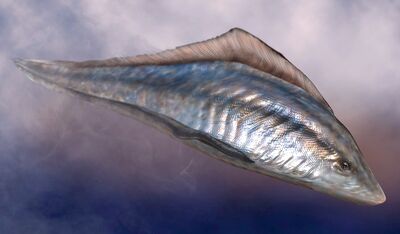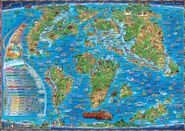(Adding categories) Tag: categoryselect |
(Adding categories) |
||
| (7 intermediate revisions by 4 users not shown) | |||
| Line 4: | Line 4: | ||
|period=Early Cambrian (Chengjiang - Emu Bay Shale) |
|period=Early Cambrian (Chengjiang - Emu Bay Shale) |
||
|phylum=Chordata}} |
|phylum=Chordata}} |
||
| − | '''Myllokunmingia''' is a chordate from the Lower Cambrian Maotianshan shales of China, thought to be a vertebrate, although this is not conclusively proven. It is 28 |
+ | '''Myllokunmingia''' is a chordate from the Lower Cambrian Maotianshan shales of China, thought to be a vertebrate, although this is not conclusively proven. It is 28 mm long and 6 mm high. |
It is among the oldest possible craniates, found in the lower Cambrian Chengjiang (524 million years ago). It appears to have a skull and skeletal structures made of cartilage. There is no sign of mineralization of the skeletal elements (biomineralization). |
It is among the oldest possible craniates, found in the lower Cambrian Chengjiang (524 million years ago). It appears to have a skull and skeletal structures made of cartilage. There is no sign of mineralization of the skeletal elements (biomineralization). |
||
| − | The holotype was found in the Yuanshan member of the Qiongzhusi Formation in the Eoredlichia Zone near Haikou at Ercaicun, Kunming City, Yunnan, China. The animal has a distinct head and trunk with a forward sail-like (1.5 |
+ | The holotype was found in the Yuanshan member of the Qiongzhusi Formation in the Eoredlichia Zone near Haikou at Ercaicun, Kunming City, Yunnan, China. The animal has a distinct head and trunk with a forward sail-like (1.5 mm) dorsal fin and a ventral fin fold (probably paired) further back. The head has five or six gill pouches with hemibranchs. There are 25 segments (myomeres) with rearward chevrons in the trunk. There is a notochord, a pharynx and digestive tract that may run all the way to the rear tip of the animal. The mouth cannot be clearly identified. There may be a pericardic cavity. There are no fin radials. There is only one specimen, which has the tip of the tail buried in sediment. |
Only one species is known – Myllokunmingia fengjiaoa (Shu, Zhang & Han). |
Only one species is known – Myllokunmingia fengjiaoa (Shu, Zhang & Han). |
||
Related creatures are [[Haikouichthys]] and [[Zhongjianichthys]]. |
Related creatures are [[Haikouichthys]] and [[Zhongjianichthys]]. |
||
| + | |||
| + | ==Gallery== |
||
| + | <gallery> |
||
| + | Prehistoric world map.jpg |
||
| + | </gallery> |
||
| + | |||
[[Category:Chordates]] |
[[Category:Chordates]] |
||
[[Category:Prehistoric fish]] |
[[Category:Prehistoric fish]] |
||
[[Category:Fish]] |
[[Category:Fish]] |
||
[[Category:Cambrian]] |
[[Category:Cambrian]] |
||
| + | [[Category:Aquatic Creatures]] |
||
| + | [[Category:Aquatic life]] |
||
| + | [[Category:Aquatic animals]] |
||
| + | [[Category:Fossils in the Animal Crossing series]] |
||
| + | [[Category:Fossil taxa described in 1999]] |
||
| + | [[Category:Myllokunmingiidae]] |
||
| + | [[Category:Agnathans]] |
||
| + | [[Category:Cambrian animals]] |
||
| + | [[Category:Extinct animals of China]] |
||
| + | [[Category:Prehistoric animals of China]] |
||
| + | [[Category:Vertebrates]] |
||
| + | [[Category:Prehistoric animals of Asia]] |
||
| + | [[Category:Extinct animals of Asia]] |
||
Revision as of 13:49, 5 May 2021

| Myllokunmingia | ||||
|---|---|---|---|---|
| Name | Myllokunmingia | |||
| Phylum | Chordata | |||
| Period | Early Cambrian (Chengjiang - Emu Bay Shale) | |||
Myllokunmingia is a chordate from the Lower Cambrian Maotianshan shales of China, thought to be a vertebrate, although this is not conclusively proven. It is 28 mm long and 6 mm high. It is among the oldest possible craniates, found in the lower Cambrian Chengjiang (524 million years ago). It appears to have a skull and skeletal structures made of cartilage. There is no sign of mineralization of the skeletal elements (biomineralization). The holotype was found in the Yuanshan member of the Qiongzhusi Formation in the Eoredlichia Zone near Haikou at Ercaicun, Kunming City, Yunnan, China. The animal has a distinct head and trunk with a forward sail-like (1.5 mm) dorsal fin and a ventral fin fold (probably paired) further back. The head has five or six gill pouches with hemibranchs. There are 25 segments (myomeres) with rearward chevrons in the trunk. There is a notochord, a pharynx and digestive tract that may run all the way to the rear tip of the animal. The mouth cannot be clearly identified. There may be a pericardic cavity. There are no fin radials. There is only one specimen, which has the tip of the tail buried in sediment. Only one species is known – Myllokunmingia fengjiaoa (Shu, Zhang & Han). Related creatures are Haikouichthys and Zhongjianichthys.
